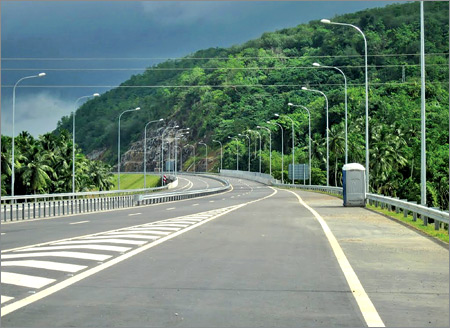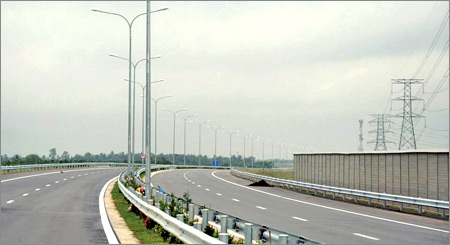|
Sri Lanka's road network:
Fast-track route to prosperity
By Ranil Wijayapala
 |
|
The Southern Expressway |
The vision of a leader is the key factor
that can stimulate any nation to tread the path of development. When Sri
Lanka's development was held back for decades due to terrorism that
engulfed the country, Mother Sri Lanka was desperately in need of a
person who had the vision to fast-track the development which the
country had been deprived of during the three decades of terrorism.
It was President Mahinda Rajapaksa who prioritised the requirements
of the nation through his vision for the country - the Mahinda Chinthana
in 2005 and Mahinda Chinthana Idiri Dekma - Forward Vision and geared
the country to achieve those goals set out in his vision through
multi-pronged approaches.
While providing a visionary and courageous leadership to the Security
Forces to defeat LTTE terrorism, he lined up other development
priorities after laying strong foundations for each of these sectors to
grow fast with the liberation of the country from the clutches of
terrorism.
Therefore, the development of the road network has always been a
priority of his vision in the country even before he became the
President of Sri Lanka in November 2005.
When he was elected Prime Minister after the April 2004 General
Election, he also held the portfolio of Highways through which he laid a
strong foundation to improve the road network of the country as he
always believed that an improved road network and reduced travel time
supplemented development and established closer links between people.
 |
|
The Colombo -
Katunayake Expressway |
During his tenure as the Prime Minister and the Minister of Highways,
he put into practice his understanding of the importance of developing
the road network in the country with equal emphasis on urban and rural
areas as more than 50 percent of the entire road network, including
national and provincial roads, was in deplorable condition, requiring
either rehabilitation or upgrading during that time.
Major challenges
There was a need to address the issues of inadequate capacity of
trunk roads posing major challenges to the fast growing traffic due to
traffic levels on the roads which had exceeded the design capacity and
the reduced capacity of the road network due to unchecked roadside
development. The road development projects also had to be undertaken,
expecting the 50 percent of the population to live in urban areas in the
country by 2015. Apart from that, rehabilitating the road network that
was destroyed in the 2004 Boxing Day tsunami had to be accommodated in
the agenda of road development.
To face the challenges in the road development sector due to
financial constraints, he also took initiatives to increase Government
allocations on road infrastructure, surpassing the allocations in many
other sectors.
The preparation of the National Road Master Plan from 2007 to 2017
under his directive came in handy to address all the issues relating to
the road development sector in the country.
That resulted in the launch of the Maga Neguma Rural Road Development
program, a mass participatory program aimed at improving the rural road
network as well as the rural economy.
He initiated the foundation of three public-private partnership
companies using the assets of the former Road Construction and
Development Company. Action was also taken to introduce a new National
Thoroughfares Act to streamline the activities under his purview.
After being elected President, he introduced an accelerated program
for the development of the road network through the Ministry of
Highways. Several large-scale projects were undertaken, including the
construction of steel flyovers to ease traffic congestion in the Colombo
city and suburbs.
It was the rural masses who praised the Maga Neguma Rural Road
Development after it was accelerated under President Rajapaksa's
leadership to provide rural masses with better roads and access to the
main highways. The introduction of the concrete block paving method as
an effective long-lasting method for rural roads helped improve many
rural roads with the community participation bringing rays of
development to the remotest parts of the country. Through the 2010
Mahinda Chinthana Idiri Dekma - Forward Vision presented for the
Presidential Re-election, he gave much emphasis to the road development
sector as the country was by then, liberated from the clutches of
terrorism, providing free access to the landmass of the country for
development.
Topmost priority
By holding the portfolio of Ports and Highways, even after his
re-election, he emphasises the necessity to give topmost priority for
the road development sector and initiated many programs to kick start
the long delayed expressway projects.
Under his leadership, the Government negotiated foreign assistance
from many countries in Asia including China, India, Iran, Saudi Arabia,
Korea and also European countries such as the UK, Spain and France and
USA for development ventures. International aid organisations such as
the World Bank, the Asian Development Bank and the Japan Bank for
International Cooperation also extended monetary assistance.
If not for his commitment to the development of the road network in
the country, the citizens would still be trudging along the same old
bumpy roads. "The Government's emphasis on developing roads has ensured
that people spend less time on travel and have more time for work. I
feel like the country has become smaller due to improved roads,"
expressing his vision behind the development of the road network,
President Rajapaksa said.
It was due to his untiring efforts that the people of this country
were able to cruise along Sri Lanka's first expressway, the Southern
Expressway in November 2011 and later to experience the 20-minute drive
from Colombo to Katunayake along the Katunayake Expressway from October
2013.
He never had second thoughts to obtain loans for the improvement of
roads in the country as he always believed that it was one way of
accelerating the country's economic development and stimulate investment
in any part of the country. Through his vision for road development, he
has opened up even the remotest parts of the country which were closed
earlier for the main development agenda of the country.
There is no doubt that the extension of the Southern Highway up to
Matara and the completion of the Outer Circular Road connecting the
Southern Highway, the proposed Northern Highway and the Katunayake
Expressway will definitely guide the country towards development.
The rehabilitated A-9 road to Jaffna, the improved 18-bend Kandy -
Mahiyangana Road and the improved roads in the upcountry are witnesses
for development, and it was not only the South that benefited from road
development, but the entire population, in every nook and corner of the
country. One cannot forget the fact that it was President Mahinda
Rajapaksa who created the renaissance of the road network of the
country, laying the solid foundation to make Sri Lanka the 'Wonder of
Asia' soon. |

